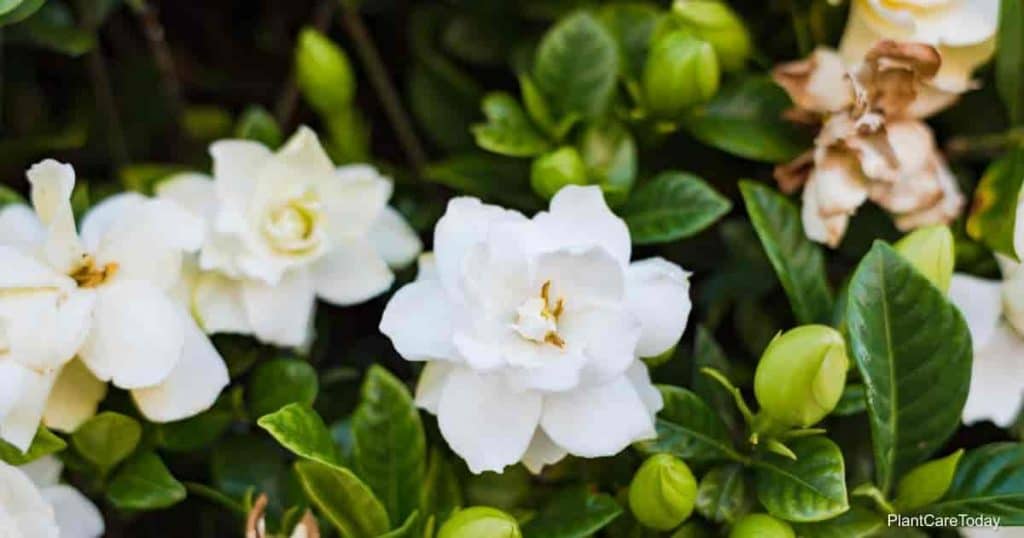There’s no denying the beauty of gardenia plants in full bloom. Yet its unique scent is the biggest draw for this higher-maintenance plant.
One thing that makes all Gardenia varieties more difficult to care for than roses or other popular flowering plants is its disease risk.

Fungal infections cause most gardenia diseases. Some are common plant problems, while others are problems Gardenias face.
Often, one must destroy a diseased plant, making prevention even more critical.
Some of the more common fungal diseases that affect gardenia include:
- Anthracnose
- Dieback
- Fungal leaf spots – young tender leaves with small round spots is Bacterial Leaf Spot. Rhizoctonia Leaf Spot shows up as tan to brown spots about 1/4″ inch diameter.
- Powdery Mildew
- Sooty Mold
Here is a quick list of other diseases and conditions Gardenia plants face:
- Blight
- Canker
- Chlorosis (Gardenia leaves turning yellow)
- Root rot
- Stem gall
How To Control Gardenia Diseases
Prevention is the key to controlling disease in your gardenias and is often the same as for other plants.
It is possible to use fungicides to combat some of these diseases, while others are terminal.
Control Method #1: Pest Control
Sooty mold and powdery mildew are often both the results of an existing infestation of honeydew-producing insects such as aphids and mealybugs.
Check your gardenias and any nearby plants often for signs of an infestation. Don’t forget the undersides of leaves.
Stop any infestation you find using an insecticide or neem oil.
You can also use preventative neem treatments or attract natural predators to your garden.
Control Method #2: Don’t Stress
Gardenias can be finicky, and it’s easy for one to get stressed, making it more susceptible to infections and Gardenia bud drop.
Follow a watering routine, and check the soil regularly to make sure you don’t overwater or underwater the plant. Overwatering and poor soil drainage lead to root rot.
Also, be sure to keep a strict Gardenia fertilizer schedule and repot as needed to prevent bound roots or compacted soil.
Finally, try to keep ideal environmental conditions for your gardenia, such as:
- proper lighting
- humidity
- airflow requirements
Control Method #3: Avoid Exposure
One of the first things to do when one of your plants gets sick is to isolate it and any others that are close to it.
This can be difficult in a garden setting. You usually must sacrifice the infected plant in hopes of preventing spread.
Take some time to learn about different common plant fungi and how they spread. Give your plants regular examinations.
Treat your gardenia to a neem oil soak to protect them for a few weeks from piercing or chewing insects. It also combats some types of bacteria and fungi.
Finally, never plant a gardenia in used soil or in a garden spot that recently had a disease or infestation problem.
More on Can You Reuse Potting Soil and a Good Soil for Gardenia Plants
- Avoid overhead watering which can spread disease and fungus spores.
- Provide Gardenia plants with good air circulation
- Give Gardenia plants plenty of sunlight. Details on Gardenia Light Requirements
The Gardenia Stem Canker
One fungal disease that requires special note is a gardenia-specific form of stem canker.
The fungus Phomopsis gardeniae causes stem cankers. The cankers are dark oval spots that run vertically up the plant’s stem.
These brownish areas may be soft or sunken, and will eventually harden and crack.
When several cankers appear in a small area, they can develop into galls.
Galls are swollen areas that usually appear near the gardenia’s base and can turn the stem above them bright yellow.
Prevention is crucial as both conditions can stunt and kill your gardenia plant, leaving it unsavable.
Prune away any damaged parts when you find them. This fungus is airborne and enters through open wounds.
Regular maintenance and care routines will also help relieve the plant’s stress. Finally, avoid planting new plants in a place where an infected gardenia had been. The spores can survive for a long time and thrive in high humidity or moist conditions.
